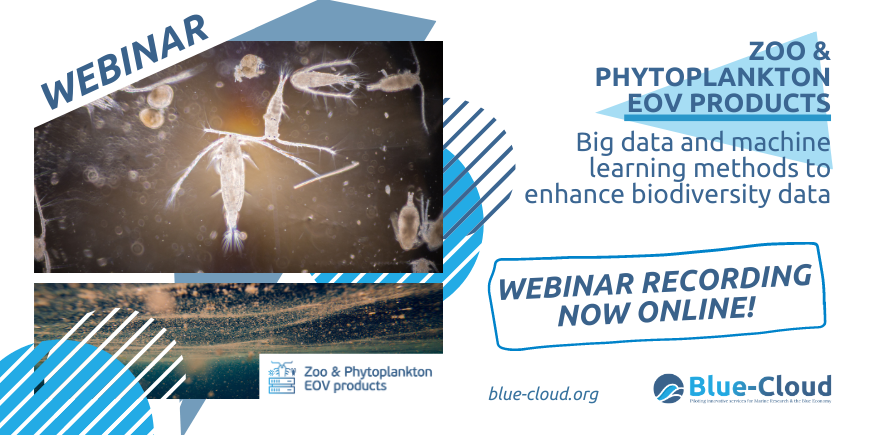WEBINAR: Zoo & Phytoplankton EOV Products

Zoo & Phytoplankton EOV Products: Big data and machine learning methods to enhance biodiversity data
After the successful first webinar in June 2020, introducing the five Blue-Cloud real-life demonstrators, we have launched a series of individual virtual meetings to discover each demonstrator. Experts from the partners involved will provide the most relevant details about the technical and conceptual issues that are being tackled thanks to the Blue-Cloud framework.
The fourth webinar took place on 12 February 2021, introducing "Zoo and Phytoplankton EOV Products", the demonstrator developed by the Flanders Marine Institute (VLIZ), in collaboration with the Faculty of Science and Engineering at Sorbonne University.
The demonstrator will compile and process several data resources that are available under different European marine networks, data systems and research infrastructures and apply big data analysis and machine learning (e.g. neural networks) methods to create fit for purpose data products, using an open transparent methodology that runs in the Blue Cloud. It will focus on biological Essential Ocean Variables (EOV’s) on plankton.
A method for creating gridded climatologies from zooplankton observations, developed by the GHER of the University of Liège using the variational inverse method and a neural network, will also be presented.
Discover the Zoo and Phytoplankton EOV Products demonstrator
Download the slides
Agenda
- 10:00: Introduction, Blue-Cloud Vision and Mission, by Sara Pittonet Gaiarin, Trust-IT Services.
- 10:05: Zoo & Phytoplankton EOV demonstrator insights, by Patricia Cabrera, VLIZ.
- 10:10: Deriving global ocean 3D Chlorophyll-a concentrations using machine learning techniques, by Renosh Pannimpullath Remanan, Laboratoire d'Océanographie de Villefranche.
- 10:20: Deriving gridded data products for zooplankton distribution using variational analysis and neural networks, by Alex Barth, University of Liège.
- 10:30: Modelling zoo and phytoplankton interactions, by Gert Everaert, VLIZ
- 10:40: Next steps by Patricia Cabrera, VLIZ.
- 10:45: Q&A
Speakers
Sara Pittonet Gaiarin (Trust-IT Services), Senior Project Manager and Coordinator of the Blue-Cloud initiative
Patricia Cabrera (VLIZ) is a marine biologist with experience in biodiversity projects, both at the scientific level and project management. She is a member of the Data Centre in the Flanders Marine Institute (VLIZ), where her work focuses on the integration of new types of biological data in the European marine infrastructures. She is leading the Phyto-Zooplankton Essential Ocean Variables (EOV) demonstrator, which will demonstrate the potential of the thematic European Open Science Cloud (EOSC) project Blue-Cloud.
Renosh Pannimpullath Remanan (Laboratoire d'Océanographie de Villefranche - LOV) is a postdoctoral researcher at LOV, Sorbonne Université. He holds a Master’s degree in Oceanography from Cochin University of Science and Technology, Kerala, India and a Ph.D. in Oceanography from the Lille1 University of Science and Technology, Lille, France. In the Blue-Cloud project (Demonstrator-1), he works on developing global 3D Chlorophyll-a concentrations and Phytoplankton size classes using machine learning techniques. His research interests include Oceanography, Ocean color remote sensing, Marine optics, Time-series analysis, and Machine learning techniques.
Alexander Barth (University of Liège) is a FNRS researcher working in the physical oceanography group GHER (GeoHydrodynamics and Environment Research). He is mainly interested in ocean modelling, data analysis and data assimilation. The GHER develops various tools for data analysis for satellite data (DINEOF, Data Interpolating Empirical Orthogonal Functions) and in situ observations (DIVAnd, Data-Interpolating Variational Analysis in n dimensions). Recently Alexander Barth developed a method to reconstruct missing data in satellite observations using a deep neural network called DINCAE (Data-Interpolating Convolutional Auto-Encoder). He is currently focusing his work to combine classical data analysis techniques with neural networks.
Gert Everaert (VLIZ) leads the research unit on ‘Ocean and Human Health’. In this interdisciplinary field of research, he aims to improve our understanding of the public health benefits (or drawbacks) of marine and coastal ecosystems. The team consists of 2 post-doctoral researchers, 4 PhD students, and project-based co-workers. The team collaborates with biologists, engineers, sociologists, economists, psychologists, and medical doctors at national and international level in multiple research projects (JPI Oceans, Interreg, VLAIO, H2020, etc.). In addition, plastic-related research is high on the team's research agenda, aiming to assess its presence, effects, and risks in and for marine life. Part of Gert's time is dedicated to his function as data science manager to initiate, lead, and perform data-driven research activities.